Stocks Distributing Into Weak Hands, Politicians With the Worst of Intentions
Stock-Markets / Financial Markets 2010 Aug 16, 2010 - 01:56 AM GMTBy: Steve_Betts
 Ancient Rome declined because it had a Senate, now what's going to happen to us with both a House and a Senate? - by Will Rogers, humorist
Ancient Rome declined because it had a Senate, now what's going to happen to us with both a House and a Senate? - by Will Rogers, humorist
Housing foreclosures hit new highs last month as the hangover from the housing bubble continues. It is estimated that 32% of all mortgages now have negative equity, meaning the debt on the house exceeds the value of the house. So here’s a question: if you bought a house for US $400,000, you have a mortgage on it for $350,000, and it’s worth US$ 225,000, what is the proper business decision to make? I’m not talking about the moral dilemma here; I am simply looking at it as a business decision.
Assuming you have a ten year mortgage, you’ll probably pay close to US $600,000 in capital and interest for a property that will be lucky to be worth half of that in ten years. One thing I can say is that it won’t be worth US $600,000 in ten years. On the other hand you can put that same US $600,000 in 30-day treasuries, over time of course, and probably make another US $100,000 over that same period. A smart investor wouldn’t think twice about what to do. You drop the keys on your banker’s desk and you wish him luck. As far as future construction is concerned, banks simply aren’t lending so new housing starts will not improve anytime soon.
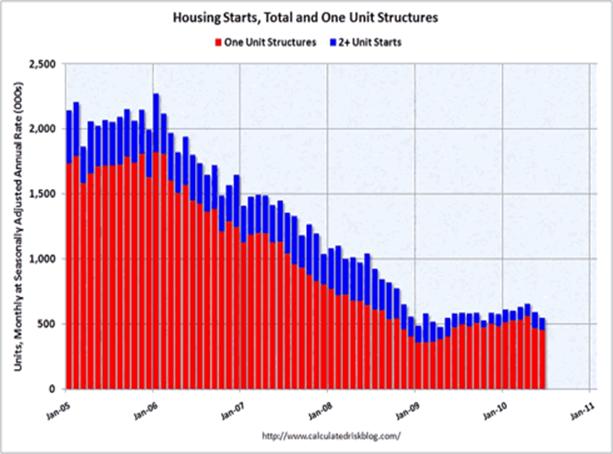
Employment also gave us an unpleasant surprise this week as the initial jobless claims were up by 2,000 versus expectations for a decline of 17,000. What’s more we’ve seen the propensity of companies to accumulate cash instead of investing in plants, machinery and jobs for the future. By now most companies have figured out ways to cut labor and still turn a profit, so they’ll keep on cutting until it affects the bottom line. On the other hand city, state and federal governments are not taking bids on labor intensive infrastructure projects (water, sewer, energy and highways) as Obama promised way back in March 2009.
In Europe we saw a resurgence in the sovereign debt quandary. You might recall that two months ago the Greek crisis was all over the newspapers and the European Central Bank (ECB) was obliged to author a Fed style bail out to the tune of one trillion dollars. As we saw in the United States, a trillion dollars just doesn’t go as far as it used to. This week the ECB was forced to intervene in the bond markets and buy Irish, Greek, Spanish, and Italian debt. In spite of the intervention, interest rates continued to rise on the aforementioned countries debt throughout the week. Back in the US Congress came back from recess to approve US $26 billion in emergency aid for states that were with their financial backs against the wall. This aid was destined for teachers and first responders and will be the first of many bailouts for states that are deep in the red. The money going to buy sovereign debt will never produce any growth as it goes into the coffers of the major banks that refuse to loan any of it out.
It’s hard to hide the truth in the Age of the Internet although printing the truth may get you branded as a fringe element, crackpot, or worse yet, land you a spot on the terrorist watch list. The one thing you can’t fool though is the market although the Fed has been trying to do just that for more than a decade. In the US every one follows the basic Keynesian premise that when things get bad the government must step in and spend. The inverse should occur when times are good and the Fed has to step in to drain liquidity from the economy. If the premise is followed recessions will never be very bad and the good times will never get out of hand. That’s the theory. The reality is completely different. For almost two decades the Fed has found excuse after excuse to pump liquidity into the system: Mexico, Russia, Asia, the Tech Wreck, 9/11, and the housing bubble were just some of the excuses used to grease the wheels. On the other hand when things were heating up, they used a form of stealth pump priming in order to keep the party going. By that I mean they would raise rates while increasing the money supply at the same time; and that’s the rub, they always increased the money supply.
Keynesian economics acted as the Fed’s crutch during the difficult times but was all but forgotten during the good times. Myopic politicians on both sides of the isle, only capable of asking for more, made sure that no one asked the difficult questions. Aside from that Washington used every problem as an excuse to expand the bureaucracy, adding layer upon useless layer of laws designed to limit individual freedom and create dependency on the State, in order to protect the corrupt system they created. They even went so far as to convince Americans that debt was really a desirable asset, and a dumbed down electorate went along with the program! Banks were the primary beneficiaries as they packaged all the debt into nice neat little parcels and sold it to widows, orphans, school teachers, first responders are your pension fund under the guise of “safe investments”. Institutions like Lehman Brothers and Merrill Lynch even went so far as to guarantee the capital in some of the packages they sold. As it turns out that guarantee didn’t go too far.
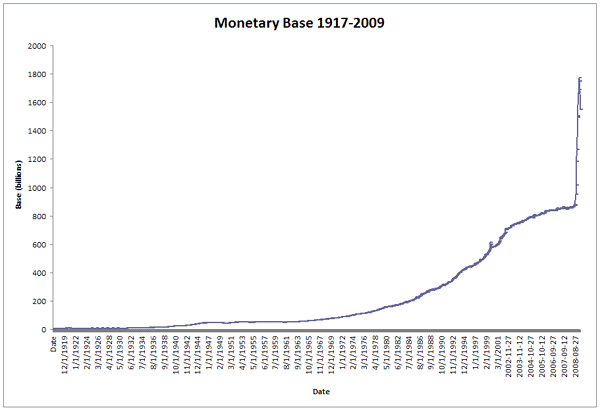
Source: Mises.org
You can see the growth in the money supply during the Greenspan regime and then the vertical lift-off when Helicopter Ben entered the scene. More fiat currency was the panacea for whatever ailed the United States as the powers that were in charge decided they simply would no longer tolerate bad times. There were not going to be any more bear markets on their watch, as long as they had a decent supply of printers ink and paper. The idea of letting a bear market run its course was completely unacceptable. Bear markets run their course in three phases and erase anywhere from a third to all of the gains of the previous bull market. The previous bull market in the Dow lasted twenty-five years (1982 to 2007) and ran from 776 to 14,164, an amazing feat when compared to its predecessors. Furthermore the last leg of the bull market was fueled by the general public piling in and ran from 2002 to 2007. In terms of points the last leg up took it from 7,250 to the all-time high of 14,164.
A bull market that persists for twenty-five years cannot be eradicated or equalized by a reaction that lasts sixteen months, especially when that reaction never produced cheap stocks. I am convinced that the first phase of the bear market began in October 2007 and lasted until March 2009, effectively erasing the entire gains from the last leg up, or blow-off phase of the bull market. In the process it planted the seeds in investors’ minds that something might be genuinely wrong with the financial markets, but it did not produce fear and that is an important distinction! For proof you’ll
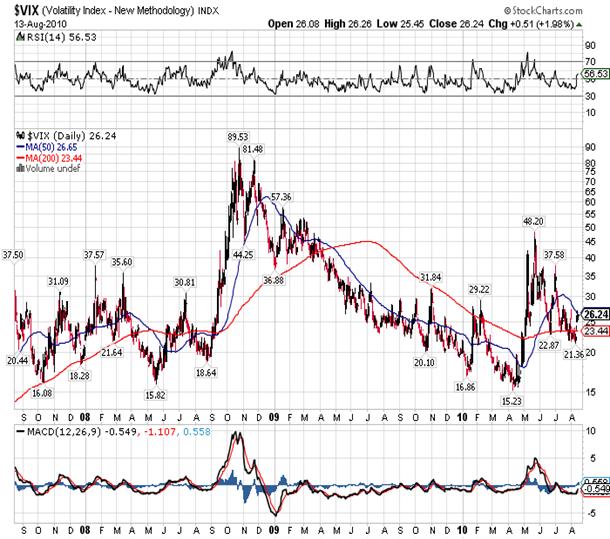
be able to look at the VIX and see that while it did hit 80, it never ran up to 150 like it did back in 1987. So the first move down came to an end in March 2009 as a result of combined intervention on the parts of both the Fed and the Department of the Treasury. They poured trillions of dollars into the major financial institutions in order to cut the bear market off at the knees, effectively eliminating (so they thought) both the second and third phases, and that’s something that’s never been done before.
The second leg down in a bear market is usually the longest phase and the general public slowly comes to the realization that something is wrong and begins to exit the market. This is followed by the third phase of the market when everyone heads for the door at the same time and declares “never again”! It produces an attitude of black despair and where buyers are few and far between. This happened in late October 1907 when you went a whole day without so much as one bid to buy a stock. A short seller could name any price and get it, to the point where great stocks sold at four times earnings, a long way from the nineteen times earnings we see today. I contend that this three phase bear market process would have occurred way back in 1999, but the Fed was determined not to let it run its course and intervened. If I am correct that means that the bear was kept in his cave for eight long years and not allowed to express itself. Meanwhile the US government in particular and the American people in general piled up huge debts that could never be repaid.
The debt was a trade-off for consumption and the illusion of growth. I say it’s an illusion because consumption was 75% of GDP, it came from borrowed money, but it never produced anything in real terms. In spite of the warning signs the Fed kept priming the pump and Americans kept on spending, until one day in early October 2007 it all came to an end. The economy began to shrink, Americans decided to save instead of trying to feed their consumption habit, unemployment began to rise, and people began to question what was happening. The Fed injected liquidity into the system by the trillions, really nothing more than debt in the name of the American people, and the market turned back up. Bernanke and Geithner went before Congressional committees and received the celebratory pats on the back along with the thanks of a grateful nation for saving the economy. The bear had been given a strong dose of sedatives and was pushed back into his cave. A new bull market was born, or was it?
From the March 2009 bottom the Dow ground higher until April 26th of this year, but it did it on declining volume. When the Dow began to recoup some of its losses in April and May of 2009 volume was running close to eight billion shares a day, and now a good day is four and a half billion shares. What’s more down days are almost always on higher volume meaning that the market was continuing to distribute shares from stronger hands into weaker hands. Then we have the issue of 90% days. Since the market ran out of steam on April 26th, there have been twenty-three 90% days, twelve 90% down days and eleven 90% up days. Going all the way back to the 1907 crash, there has never been a similar period in market history. In fact nothing even comes close! That tells me the stock market is suffering from severe internal distress, and that stress is a result of the distortions conjured up by the Federal Reserve’s failed policies.
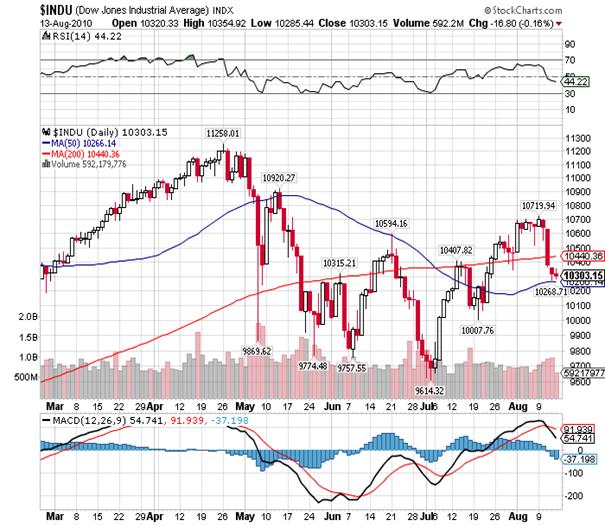
As I said before the Dow topped on April 26th and promptly gave up 14% of its value over the next forty-nine sessions, bottoming at 9,614 on July 2nd. With respect to the Dow’s April 26th closing high, it should be mentioned that the Transports went on to make a higher unconfirmed closing high on May 1st. It should also be mentioned that the April 26th closing high was almost exactly a .618 Fibonacci retracement of the initial leg down from the all-time high. This is the inverse of what happened back in October 2007 as the Transports failed to confirm the Dow’s closing high, signaling the end of the bull market. So both the October 2007 and April 2010 tops were major non-confirmations indicating the end of a big move. Now comes the hard part! Two weeks ago both the Dow and the Transports closed above their respective June closing highs and thereby triggered a Dow Theory buy signal. Since then both indexes have gone on to make higher closing highs on several occasions, the last one being on August 9th and then they both turned down with the Transports leading the way. On Friday the Dow finished down 16 points at 10,303, four days off of the high, and again well below the 200-dma.
What’s more the RSI, MACD, and histogram are all headed lower and the Dow finished below what should have been good Fibonacci support at 10,334. This has obviously shaken the Fed up and they did note more weakness than expected in the economy in their last statement. Now the expectations are high for another stimulus package and the bond market has already priced that in. Many think the stock market will surge on the promise of trillions more coming down the pipeline, but I think the market is taking this as a sign of failure and that’s why we had a 97% down day the day after the Fed statement was released. Normally such a disastrous down day is a sign that investors have exhausted the urge to sell, but not this time around. Instead we saw continued selling on Thursday and Friday and every attempt to push stock prices higher was met by even more selling. That is not a common place event and fits right in with all of the strange occurrences we are seeing in the market place.
As a result I now believe the last Dow Theory buy signal is an error brought about by all the stress and distortions in the system. I also believe that all of this will be washed out of the system in a violent and brutal fashion. I do not see how the Dow can move back above the April 26th closing high, and I suspect the August 9th high may have been it. The Dow had good resistance in the 10,633 to 10,659 area and it couldn’t work through it. The Dow continues to distribute, stocks are anything but cheap, and the urge to sell has not been quenched. I believe that the April 26th high marked the end of the bear market reaction and the beginning of the second phase of the bear market mentioned previously. This second phase will take prices down below the March 2009 low, to much lower lows, and maybe all the way back to down to the 1982 low of 778.00 after the third phase kicks in. The level of complacency in the market is extremely high and tells me that the next move will be a big one, catching investors off guard.
The Fed of course will fight all of this tooth and nail, but the reality is the only option available to it is to print money. Such an option will not save the Dow, but it will destroy the US dollar. The spot US Dollar Index began
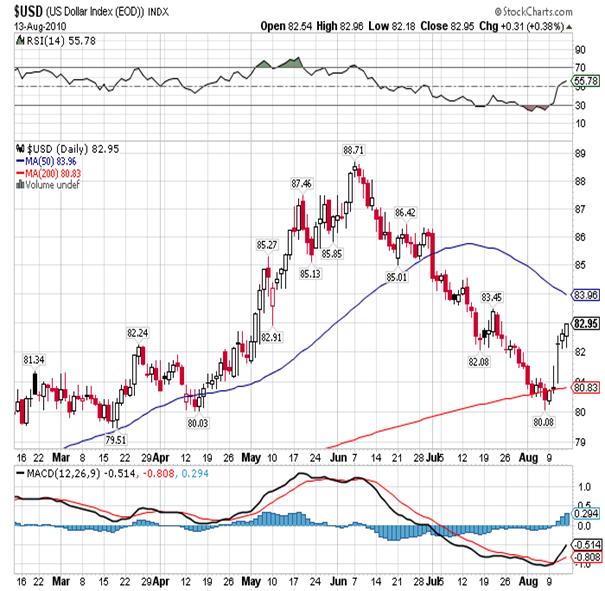
to price in future Fed action way back in the beginning of June, driving the Index down from a failed fourth attempt at the 89.97 resistance to a natural level of support at the old historic low of 80.17. Since then the US Dollar Index has rallied for five consecutive sessions and closed out the week at 82.95, midway between the 200-dma and the 50-dma. What’s more it has neutralized the extremely oversold condition that existed late last week. As I mentioned in last Sunday’s report, I was looking for a seven to nine day reaction that would test strong resistance at 83.35 and I have seen nothing so far that changes my mind.
I continue to view the 80.16 support as a line in the sand that all the major players are watching. Once it is violated the urge will be to head for the door en mass, even though common sense tells them they all can’t fit and it is self-defeating. Unfortunately markets always respond in the same fashion for the simple reason that basic human emotions haven’t changed in thousands of years. The twin towers of fear and greed rule the markets and when they take control caution is thrown to the wind. Investors, no matter how big and disciplined they are, will reach a point when they’ll decide to get out at any cost, and I believe that point will be either at 80.16 or 77.02. Can anything save the dollar? Only an honest-to-God balanced budget that produces a surplus after making provisions to pay the debt! What are the chances of that? Zero!
I am not going to discuss bonds this time around for the simple reason that they are debt and anyone who buys debt, from the world’s largest debtor, in a world flooded with debt, is a fool. You know the old saying: a fool and his money are soon parted. Instead I want to talk about gold! It’s the one thing everyone loves to hate, and that goes double for the central banks. Every time the Fed cranks out another dollar bill it weakens them, and every time gold goes up a dollar it weakens them. Think of gold as Bernanke’s kryptonite! This week the yellow metal advanced another 11.00 as it closed on Friday at 1,215.40 and in spite of numerous attempts to push the price down. Manipulation of the gold price is now overt and rampant as the Fed views the suppression of gold’s price as necessary for its survival. The countless attempts to sell the metal off at 8:45 am in the morning are so blatant that a blind man could see them, and yet they continue unquestioned.
If you take a good look at gold’s two-year daily chart you can see that it has been consolidating within a range (1,158.20 to 1,245.00) for almost four months. We have seen this type of behavior before and given that the
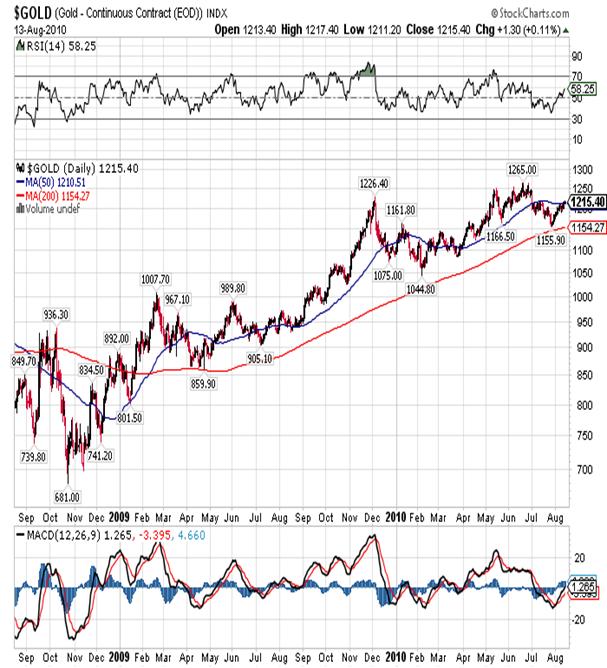
yellow metal is firmly entrenched in a bull market; the odds favor a significant breakout to the upside. I have no doubt that the breakout will occur although I can’t pick a date and I believe the move higher will test strong resistance at 1,298.10. That obviously implies new all-time highs and I don’t think gold will stop there either.
For more than a decade the Fed’s manipulative policies have been gold’s worst enemy, but now you’ll see that they’ll turn out to be gold’s best friend. That’s what happens when you distort the markets in a misguided attempt to change the primary trend. Anyone expecting gold or any other market for that matter, to react like they’ve always reacted fails to grasp the reality of what is going on in the world. The strain of carrying so much debt on the personal, municipal, state and federal level is going to push gold to heights that very few could have ever imagined. Inversely it will drive stock prices lower than anyone could have imagined. The very panacea, debt, which prolonged the good times, will cause the worst of times in the coming months and years to come. It will drive investors from all the other asset classes and into gold. The more the Fed prints the higher the price of the yellow metal will surge. Attempts at denial will only fuel the fire.
In conclusion we are witnessing the death of Keynesian economics and that should have been expected. Any economic school of thought that assumes people will back away from the punch bowl just when things are heating up, and in an environment where pork is king, was doomed from the start as it failed to comprehend basic human traits. Businesses don’t want you to back off because it would cost them money so they donate to political campaigns, and in order to raise more money politicians continue to throw wood on the fire. Lobbyists see to that! The last six or seven administrations have done so much damage to the US Constitution that it now resembles a botched abortion. Americans have given away little bits and pieces of their rights over the last two decades so that the only two alternatives available will be civil unrest or a pathetic version of crony socialism. My money is on social unrest.
As the wheels come off the government will resort to more unorthodox policies including seizures of certain types of assets, bank holidays, misinformation and worse. They’ll implement the idea that the bigger the lie, the more believable it will be. The midterm elections coming up in November will be crucial in telling us how Americans will react and whether they have what’s needed to take back all that’s been lost. This administration will stop at nothing to ensure its party maintains its majority. Obama is well on his way to becoming a one-term president but don’t think for a second that he’ll go quietly into the night. All of this will weigh heavily on the markets as investors fall into a black bearish despair. Within a year you’ll be hearing “never again” and it won’t be an echo from 1932 either. Capital will disappear like so much dust in the wind and the only ones who will come out ahead will be those who were fortunate enough to buy gold or short the stock market. If you are one of the few who’ve gone this route, my best advice is to keep it to yourself because your neighbors will be looking at you with jealous eyes.
[You can contact us at our new e-mails, info@stockmarketbarometer.net (general inquiries regarding services), team@stockmarketbarometer.net (administrative issues) or analyst@stockmarketbarometer.net (any market related observations).] By Steve Betts
E-mail: analyst@stockmarketbarometer.net
Web site: www.stockmarketbarometer.net
The Stock Market Barometer: Properly Applied Information Is Power
Through the utilization of our service you'll begin to grasp that the market is a forward looking instrument. You'll cease to be a prisoner of the past and you'll stop looking to the financial news networks for answers that aren't there. The end result is an improvement in your trading account. Subscribers will enjoy forward looking Daily Reports that are not fixated on yesterday's news, complete with daily, weekly, and monthly charts. In addition, you'll have a password that allows access to historical information that is updated daily. Read a sample of our work, subscribe, and your service will begin the very next day
© 2010 Copyright The Stock Market Barometer- All Rights Reserved
Disclaimer: The above is a matter of opinion provided for general information purposes only and is not intended as investment advice. Information and analysis above are derived from sources and utilising methods believed to be reliable, but we cannot accept responsibility for any losses you may incur as a result of this analysis. Individuals should consult with their personal financial advisors.
© 2005-2022 http://www.MarketOracle.co.uk - The Market Oracle is a FREE Daily Financial Markets Analysis & Forecasting online publication.



